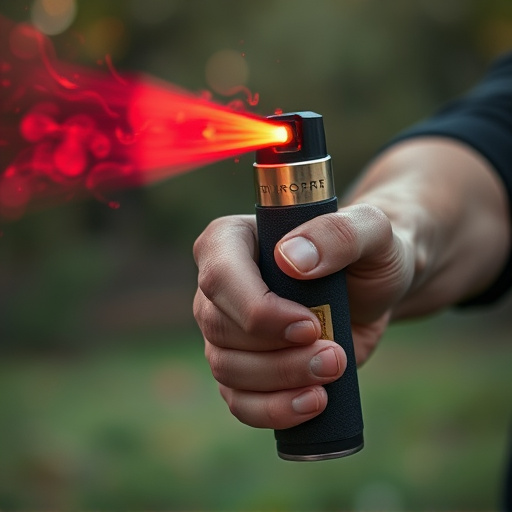"When to Use Pepper Spray Safely" emphasizes the importance of understanding oleoresin capsicum (OC) spray's physiological effects for effective self-defense. Training in aiming, distance, and de-escalation is crucial to ensure safe deployment, protect bystanders, and maximize its effectiveness as a last resort. Legal regulations vary across jurisdictions, with age restrictions, training requirements, and type/strength limitations, which must be understood for responsible use. Pepper spray is effective in close-quarters confrontations, providing temporary defense without permanent harm, especially in crowded public spaces. Safe usage involves threat assessment, adherence to local laws, and proper application techniques to minimize cross-contamination and bystander risks.
In today’s diverse and dynamic world, understanding civilian protection tools like inflammatory spray has become essential. This article delves into the multifaceted aspect of pepper spray, exploring its mechanisms, legal framework, and safe handling practices for optimal effectiveness. We navigate real-world scenarios where pepper spray proves an appropriate solution, guiding readers on when to use it responsibly, ensuring both public safety and adherence to regulations.
- Understanding Pepper Spray: What It Is and How It Works
- Legal Considerations and Regulations for Civil Protection Spray
- Safe Handling and Application Techniques for Optimal Effectiveness
- Real-World Scenarios: When is Pepper Spray the Appropriate Solution?
Understanding Pepper Spray: What It Is and How It Works
Pepper spray, also known as oleoresin capsicum (OC) spray, is a non-lethal self-defense tool designed to temporarily incapacitate an attacker. It’s a liquid compound derived from chili peppers that, when sprayed, irritates the eyes, nose, and throat, leading to temporary blindness, coughing, and difficulty breathing. This disruption creates an opportunity for the user to escape or defuse the situation.
The effectiveness of pepper spray lies in its ability to trigger a powerful physiological response without causing serious harm. When deployed safely and responsibly, it can deter aggressive behavior and provide valuable time for individuals to get to safety. Understanding how and when to use pepper spray is crucial. Proper training on aiming, distance, and de-escalation techniques ensures safe application, minimizing damage to bystanders and maximizing its effectiveness as a last resort defense mechanism.
Legal Considerations and Regulations for Civil Protection Spray
When considering the legal implications of civilian protection spray, it’s crucial to understand that regulations vary significantly across jurisdictions. In many countries and states, carrying self-defense pepper spray is legal if used responsibly and in accordance with local laws. However, specific rules dictate when, where, and how such sprays can be possessed and deployed. Users must be aware of these restrictions to ensure safe and legal use.
For instance, some regions require individuals to be at least a certain age or complete training before purchasing pepper spray. There may also be limitations on the type of spray allowed, with considerations for strength and active ingredients. Understanding these legal parameters is essential to make informed decisions about civilian protection and ensure that the spray is used safely and appropriately when facing threatening situations.
Safe Handling and Application Techniques for Optimal Effectiveness
When it comes to using inflammatory spray for civilian protection, safe handling and application techniques are paramount for achieving optimal effectiveness. It’s crucial to understand when and how to deploy this powerful tool. Pepper spray, a popular choice for self-defense, should be used as a last resort when facing an imminent threat. Always assess the situation first; if de-escalation methods fail, only then consider deploying the spray.
For safe application, keep the spray in a secure, easily accessible location until needed. Aim for the attacker’s face—eyes, nose, and mouth—for maximum impact. Maintain a safe distance, typically 2–3 feet, to avoid cross-contamination or accidental exposure. Act quickly but calmly; a firm, controlled spray burst is more effective than a prolonged, shaky spray. After use, wash your hands thoroughly and store the spray in a cool, dry place away from direct sunlight.
Real-World Scenarios: When is Pepper Spray the Appropriate Solution?
In various real-world scenarios, pepper spray can serve as an effective and safe civilian protection tool when other means fail or are not accessible. It is particularly useful in close-quarters confrontations where the user needs a quick, non-lethal way to incapacitate an attacker temporarily. For instance, in crowded public spaces like music festivals or sports events, pepper spray can help individuals defend themselves against sudden assaults without causing permanent harm. Additionally, it proves valuable during encounters with aggressive animals, providing time for escape or professional assistance.
When considering when to use pepper spray safely, it’s crucial to assess the threat level and the potential consequences. Unlike firearms, pepper spray should only be deployed when there is an imminent danger of physical harm, ensuring that its usage aligns with local laws and regulations. Training and understanding the spray’s range, effectiveness, and de-escalation capabilities are essential for responsible use. This includes learning proper application techniques to maximize its impact while minimizing cross-contamination and ensuring the safety of bystanders.
Pepper spray, as a civilian protection tool, offers a powerful yet non-lethal means of self-defense in various real-world scenarios. Understanding its mechanics and safe handling practices is paramount for optimal effectiveness. By adhering to legal guidelines and employing appropriate application techniques, individuals can ensure their safety without causing undue harm. When used responsibly, pepper spray can be a game-changer in protecting oneself and one’s loved ones against unexpected threats, making it an invaluable asset in today’s diverse and sometimes unpredictable world.
